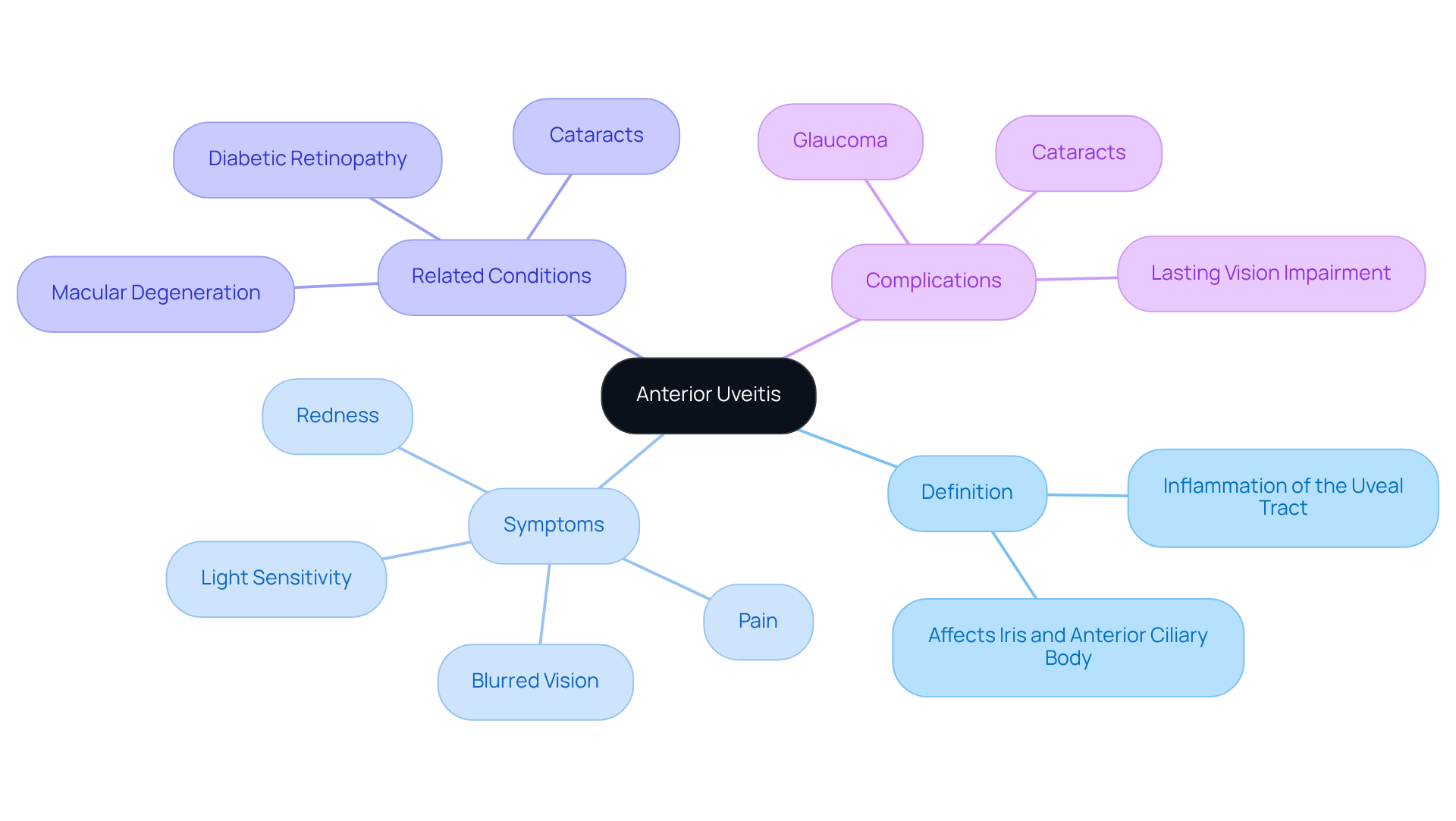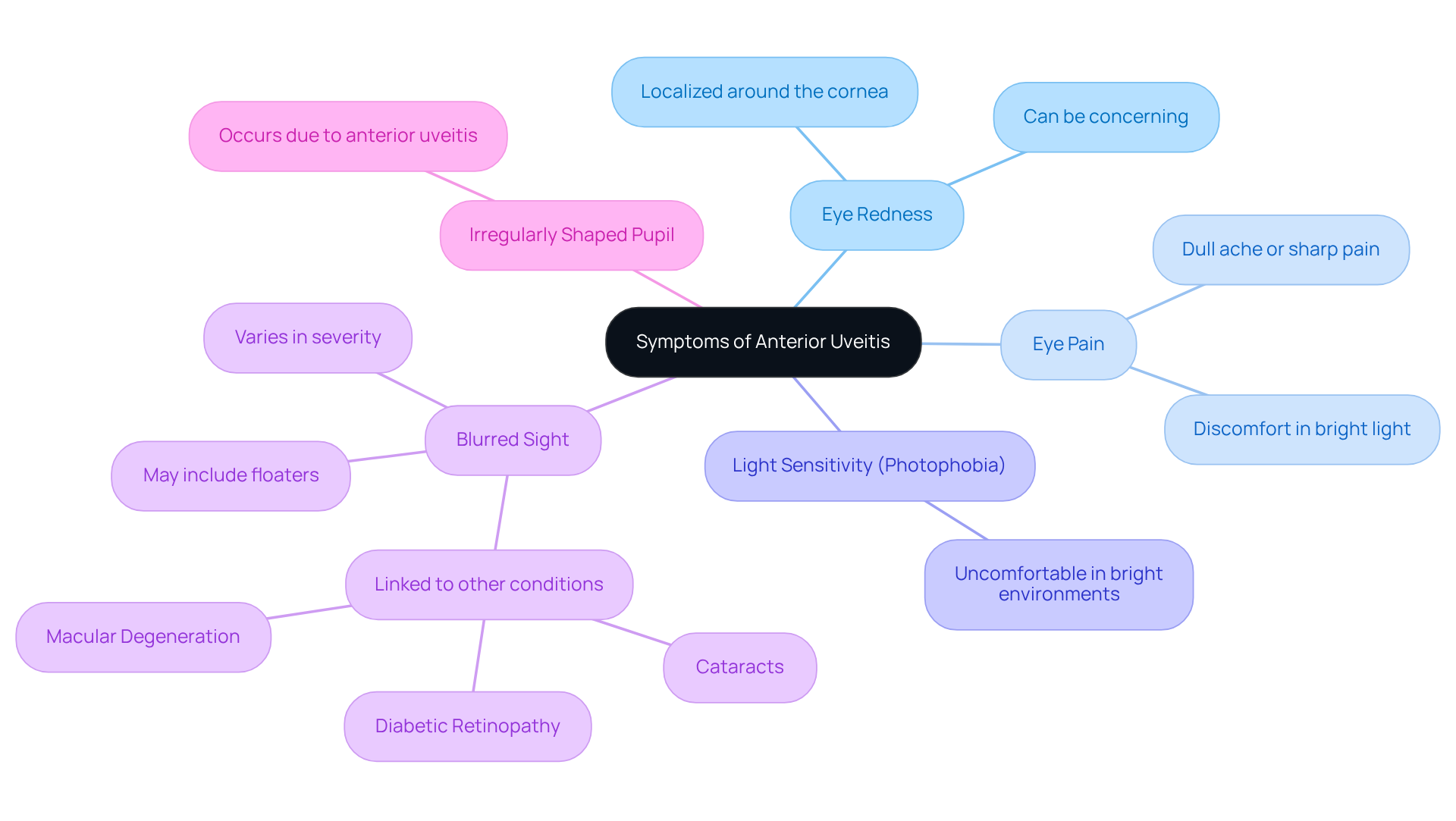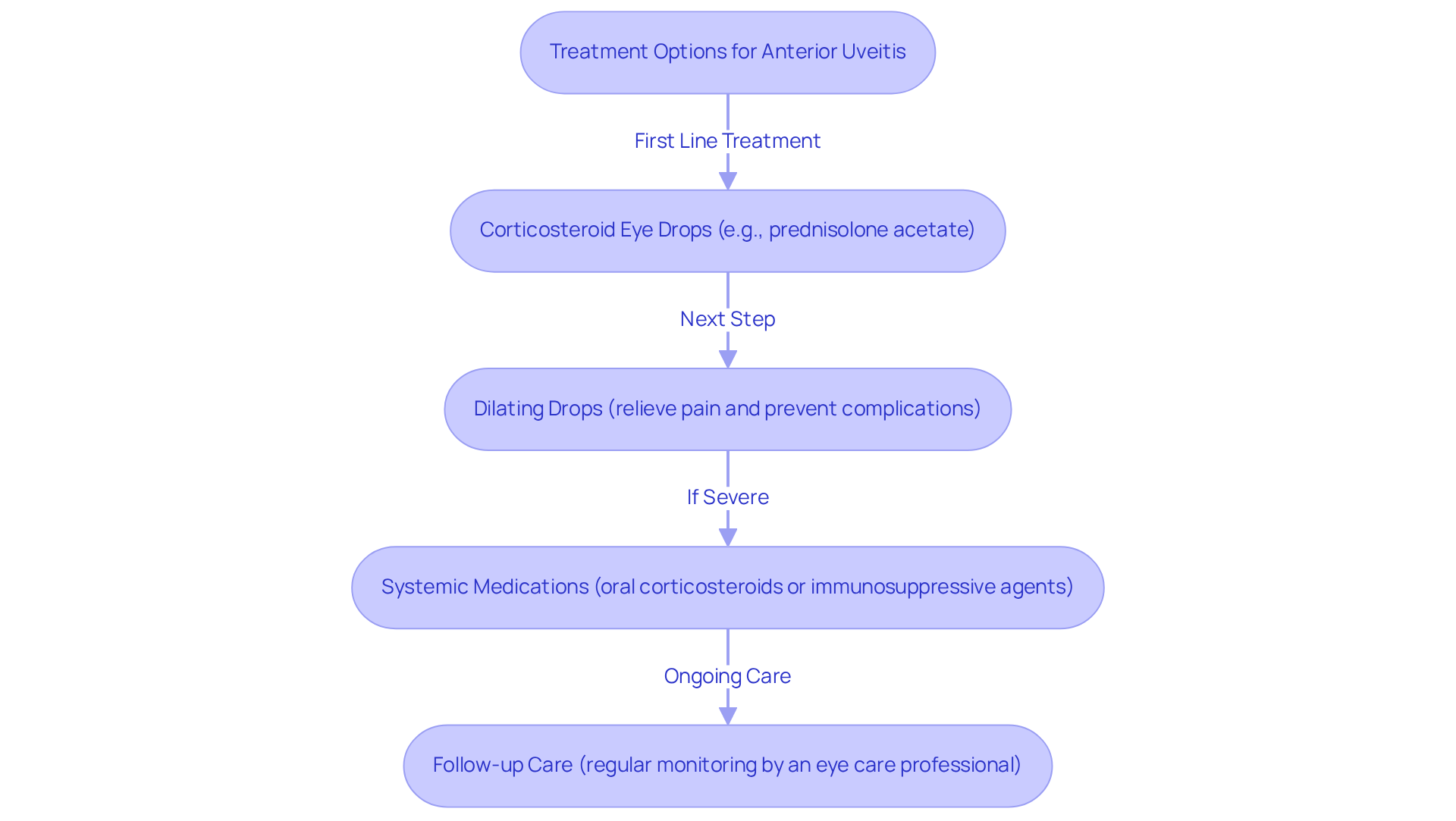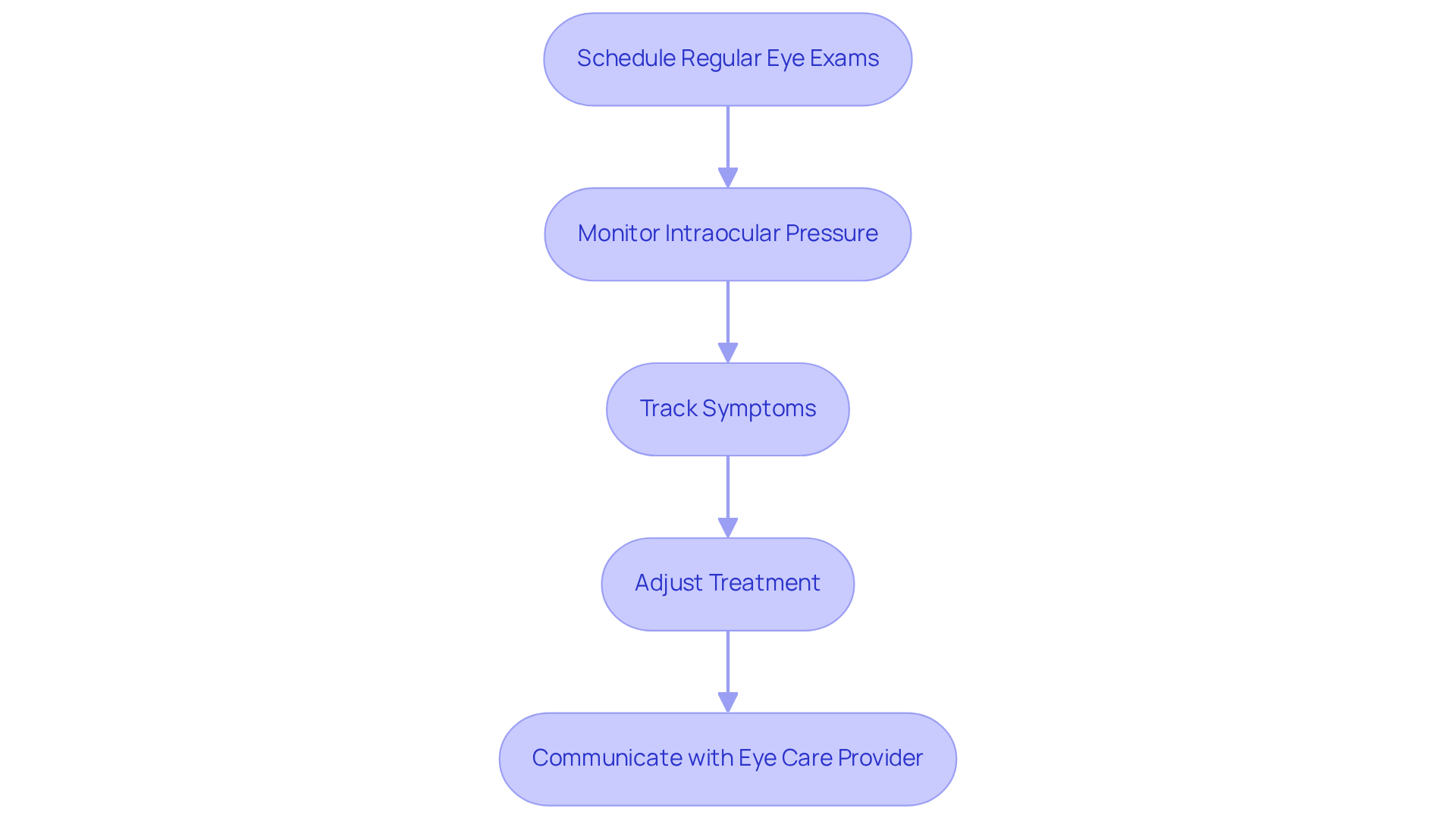Posted by: Northwest Eye in General on July 3, 2025
Overview
Anterior uveitis, also known as iritis, can be a concerning condition, as it involves inflammation of the iris and the anterior ciliary body. This may lead to symptoms such as:
- Redness
- Pain
- Light sensitivity
- Blurred vision
We understand that these symptoms can be distressing, and if left untreated, they can result in serious complications.
Effective management strategies are available to help you navigate this condition. Corticosteroid eye drops and dilating drops are commonly used to alleviate symptoms. It’s also crucial to have regular follow-up care to monitor your symptoms and adjust treatments as necessary. We emphasize the importance of timely medical intervention to ensure your well-being.
Remember, you are not alone in this journey. We are here to help you through this process, providing the support and care you need.
Introduction
Anterior uveitis is a condition that can lead to serious vision complications if left untreated. We understand that this can be concerning, especially when it manifests through troubling symptoms like:
- Redness
- Pain
- Light sensitivity
Understanding the nuances of this eye condition is essential for effective management and treatment. However, it’s common to feel overwhelmed, and many individuals remain unaware of the critical steps they can take to alleviate their discomfort and safeguard their vision.
How can you navigate the complexities of anterior uveitis to ensure timely intervention and optimal care? We are here to help you through this process.
Understand Anterior Uveitis: Definition and Overview
Anterior uveitis, commonly known as iritis, is an inflammation of the uveal tract that specifically impacts the iris and the anterior portion of the ciliary body. We understand that experiencing this condition can be concerning, as it may arise from , including autoimmune disorders, infections, or trauma. Symptoms often include:
- Redness
- Pain
- Light sensitivity
- Blurred vision
These symptoms can stem from the swelling and inflammation that impact the eye’s ability to focus clearly.
It’s important to note that blurred vision can also signal other conditions, such as:
- Cataracts
- Diabetic retinopathy
- Macular degeneration
If left unaddressed, uveitis at the front of the eye can lead to serious complications, including:
- Glaucoma
- Cataracts
- Lasting vision impairment
Understanding the characteristics of this condition and its potential signs is crucial for prompt diagnosis and effective management.
If you are experiencing signs of distorted vision or symptoms of anterior uveitis, we encourage you to seek professional medical assistance promptly. Remember, you are not alone in this journey, and we are here to help you through the process.

Identify Symptoms of Anterior Uveitis
Common symptoms of anterior uveitis include:
- Eye redness: Often localized around the cornea, which can be concerning.
- Eye pain: This may feel like a dull ache or sharp pain, especially when associated with anterior uveitis or when exposed to bright light. It’s common to feel discomfort in such situations.
- Light sensitivity (photophobia): Many patients with anterior uveitis find bright environments uncomfortable, which is completely understandable.
- Blurred sight: This can vary in severity and may be accompanied by floaters, potentially linked to anterior uveitis. Blurred vision can indicate underlying conditions such as cataracts, diabetic retinopathy, or macular degeneration, which are particularly relevant for cataract patients. Identifying these signs early is crucial for successful treatment, as unattended issues can lead to severe health complications. We want to reassure you that is a vital step in your care.
- Small or irregularly shaped pupil: This can occur due to anterior uveitis. Understanding these symptoms can help you seek timely medical intervention, and we are here to help you through this process.

Explore Treatment Options for Anterior Uveitis
If you are experiencing anterior uveitis, we recognize that this can be a challenging experience. Treatment typically involves several key approaches to help alleviate your discomfort and restore your vision:
- Corticosteroid eye drops: These are often the first line of treatment to reduce inflammation. Common options include prednisolone acetate, which can provide significant relief.
- Dilating drops: These drops are helpful in relieving pain and preventing complications by keeping the pupil open, allowing for a more comfortable experience.
- Systemic medications: In cases of severe or recurrent anterior uveitis, oral corticosteroids or immunosuppressive agents may be necessary to manage anterior uveitis effectively.
- Follow-up care: Regular monitoring by an eye care professional is crucial. This allows for assessing treatment effectiveness and making any necessary adjustments. Remember, it’s always best to consult with an ophthalmologist for personalized treatment plans tailored to your needs.
We are here to help you through this process, ensuring you receive the you deserve.

Establish Follow-Up Care and Monitoring Strategies
It is essential to provide follow-up care for anterior uveitis, and we want to ensure you feel supported throughout this process. Here are some important aspects to consider:
- Regular eye exams: We recommend scheduling follow-ups within 1-7 days after your initial treatment, depending on how severe the inflammation is. It’s important to keep a close eye on your recovery.
- Monitoring intraocular pressure: Since corticosteroids can increase eye pressure, regular checks are necessary to safeguard your vision.
- Symptom tracking: We encourage you to keep a log of any changes in your symptoms. This information is valuable and should be shared during your .
- Adjusting treatment: Based on how you respond to the initial therapy, adjustments may be needed to optimize your outcomes. Consistent communication with your eye care provider is key to successful management. Remember, we are here to help you through this journey.

Conclusion
Anterior uveitis, or iritis, is an eye condition that truly deserves your attention. Recognizing its symptoms—redness, pain, light sensitivity, and blurred vision—is essential for timely intervention. We understand that experiencing these symptoms can be concerning, and seeking professional medical assistance is crucial to avoid lasting vision impairment.
To manage anterior uveitis effectively, key strategies include:
- The use of corticosteroid eye drops
- Dilating drops
- Systemic medications
- Regular follow-up care
Monitoring intraocular pressure and tracking your symptoms can play a vital role in adjusting treatment plans, ensuring your recovery is as smooth as possible. It’s important to remember that a collaborative approach between you and your healthcare provider is fundamental to achieving successful outcomes.
Ultimately, being aware of anterior uveitis and managing it proactively can significantly enhance your quality of life. If you are experiencing any symptoms, please don’t hesitate to consult with eye care professionals and follow their recommendations for care. Taking these steps not only aids in your recovery but also creates a supportive environment as you navigate this condition. We are here to help you through this process.
Frequently Asked Questions
What is anterior uveitis?
Anterior uveitis, commonly known as iritis, is an inflammation of the uveal tract that specifically affects the iris and the anterior portion of the ciliary body.
What are the common causes of anterior uveitis?
Anterior uveitis can arise from various causes, including autoimmune disorders, infections, or trauma.
What are the symptoms of anterior uveitis?
Symptoms of anterior uveitis often include redness, pain, light sensitivity, and blurred vision.
What can blurred vision indicate besides anterior uveitis?
Blurred vision can also signal other conditions such as cataracts, diabetic retinopathy, and macular degeneration.
What complications can arise if anterior uveitis is left unaddressed?
If left untreated, anterior uveitis can lead to serious complications including glaucoma, cataracts, and lasting vision impairment.
Why is it important to understand the signs of anterior uveitis?
Understanding the characteristics and potential signs of anterior uveitis is crucial for prompt diagnosis and effective management of the condition.
What should I do if I experience symptoms of anterior uveitis?
If you are experiencing signs of distorted vision or symptoms of anterior uveitis, it is important to seek professional medical assistance promptly.






